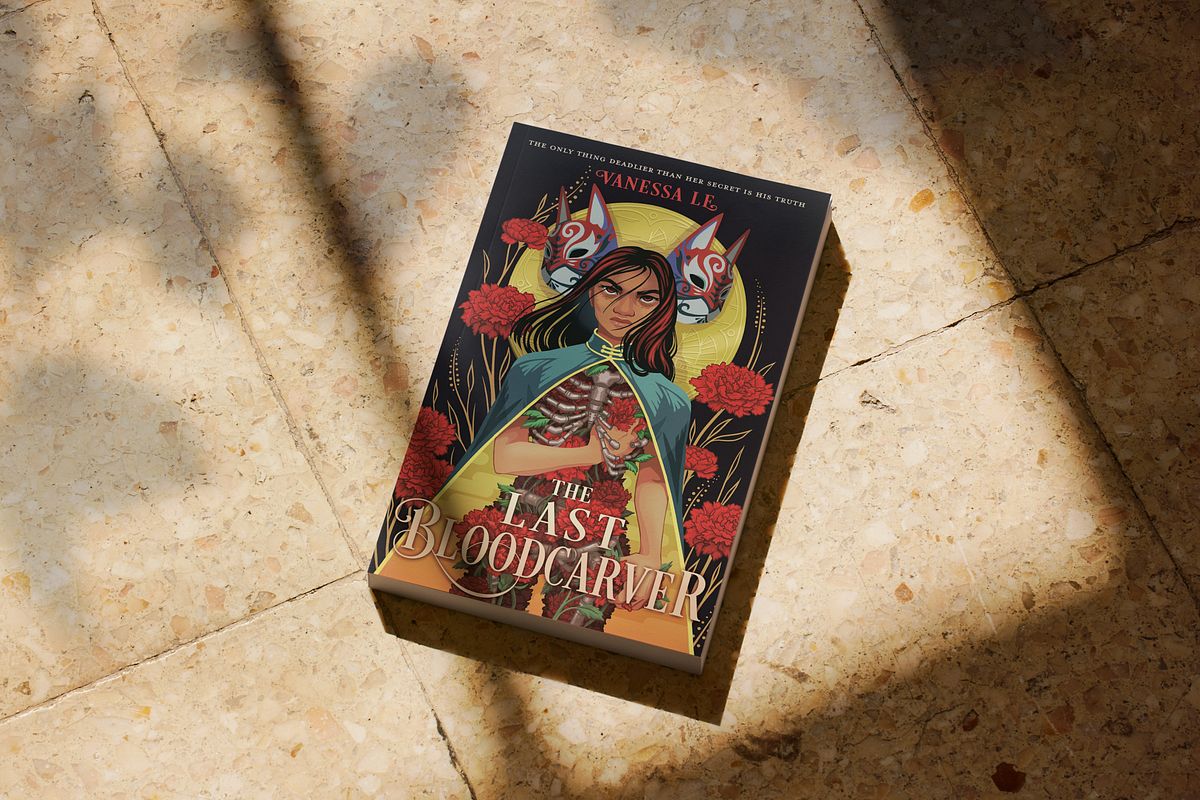Captured by Butchers, the “blackmarket bogey men who deal in rare goods,” Nhika Suonyasan is caged and auctioned off to the city’s elite. A figure in a fox mask attempting to purchase her is outbid by a rich family that carts her off to a mansion that boasts luxury beyond anything Nhika has ever seen. The family immediately commands her to heal a witness to the wealthy patriarch’s death.
Nhika, the protagonist in Vanessa Le’s debut young adult novel The Last Bloodcarver, is a heartsooth. Before being abducted and sold, she survives the streets of Theumas by her wits and audacity, hawking eucalyptus and ginseng as cures. She believes she may be the last of the Yarongese, an island people wiped out by war, genocide, human vivisection, and grotesque methods of torture. The Yarongese are, as Nhika’s grandmother would have said, the recipients of a blessing and a duty to heal. Heartsooths possess the talent to lay their hands on a body to cure it of diseases and wounds.
The devastations of war also bring dehumanization and disinformation to the fiction realm. What remains in the aftermath of the island’s genocide is a distorted mythology of Nhika's people — witches, necromancers, liver eaters. Nhika and her kind are maliciously referred to as “bloodcarvers, a breed that fell with her island.” Meanwhile, the bloodcarvers' ability to rend flesh from bone and grind bones to dust has been lost through the ransacking of medical texts as well as the massacre of elders. Nhika exists as a pariah, hunted by people who intend to kill her. Yet she is simultaneously coveted by those who hope to exploit her gift to heal.
A graduate of Brown University in Health and Human Biology, Vanessa Le breathes new life into the genre via her inclusion of science.
A graduate of Brown University in Health and Human Biology, Le breathes new life into the genre via her inclusion of science. In this YA fantasy, hearthsooths can turn off or on someone’s pain receptors, can “mute the buzz of adrenaline and stress hormones,” to heal herself or others. Le’s intimate familiarity with human biology allows her to establish elements of horror in the book as well. Bodies are exhumed. Photos of vivisections pass as medical inquiry. Mad science tips the sci-fi scales in favor of gruesome horror. And yet, Le does not hit the reader over the head with the grotesque. Its serpentine inclusion gives the reader just enough to grapple with the meaning of terror. While the inclusion of the horror genre does not overwhelm the text, it certainly is enough to let the readers know how high the stakes are for Nhika. Meanwhile, Le’s command of her craft means we need no suspension of disbelief to believe magic exists in the world.
The society Le creates fits neatly into the speculative fiction genre. In the steampunk world, automatons exist side-by-side with typewriters, while auto carriages and horse-drawn carriages populate the chapters. Sci-fi medical marvels abound in the novel’s segregated blue and silver city-state that includes sumptuous gardens residing far from Nhika’s squalor. A river that runs through the vibrant city allows junk sails to float into the harbor beside pagoda-styled roofs and domes with finials. Horror, mystery, and folklore blend as seamlessly as the real and imagined architectural styles.

The book author Vanessa Le.
One of The Last Bloodcarver’s most satisfying elements is its ability to weave folklore into the plot via small details that are rich in cultural subtext. In accordance with depictions of fox characters around the world, the mysterious man who wears the fox mask is clever and frequently takes what does not belong to him. The carp mask, however, references a more specific Asian belief. In Vietnam and nearby nations, the carp can transform into a dragon and it is thus not a surprise that during Nhika’s quest for peace, freedom and love she dons the carp mask.
One of The Last Bloodcarver’s most satisfying elements is its ability to weave folklore into the plot via small details that are rich in cultural subtext.
As an international school librarian in Vietnam, I find curating a collection that reflects the host language and foreign students to be a fun challenge. Paired with that challenge is the duty to have a balanced collection and not limit the options to narratives of war, or boat refugees, or immigration. Le does not include any of these already oft-told narratives in her book. For Le’s young adult audience, speculative fiction rules the page.
The Last Bloodcarver can fill important gaps in library collections that seek to provide “windows, sliding glass doors, and mirrors” to representation. Young readers get to see and read characters with their names, customs, and folklore, all while getting adventure, sci-fi, and let’s face it, a smidge of romance. Have you ever met a teenage reader who doesn’t like a smidge of it? Can a librarian curate a collection without it? Librarians that seek to diversify their collections with authentic voices must surely include The Last Bloodcarver on their shelves.
















